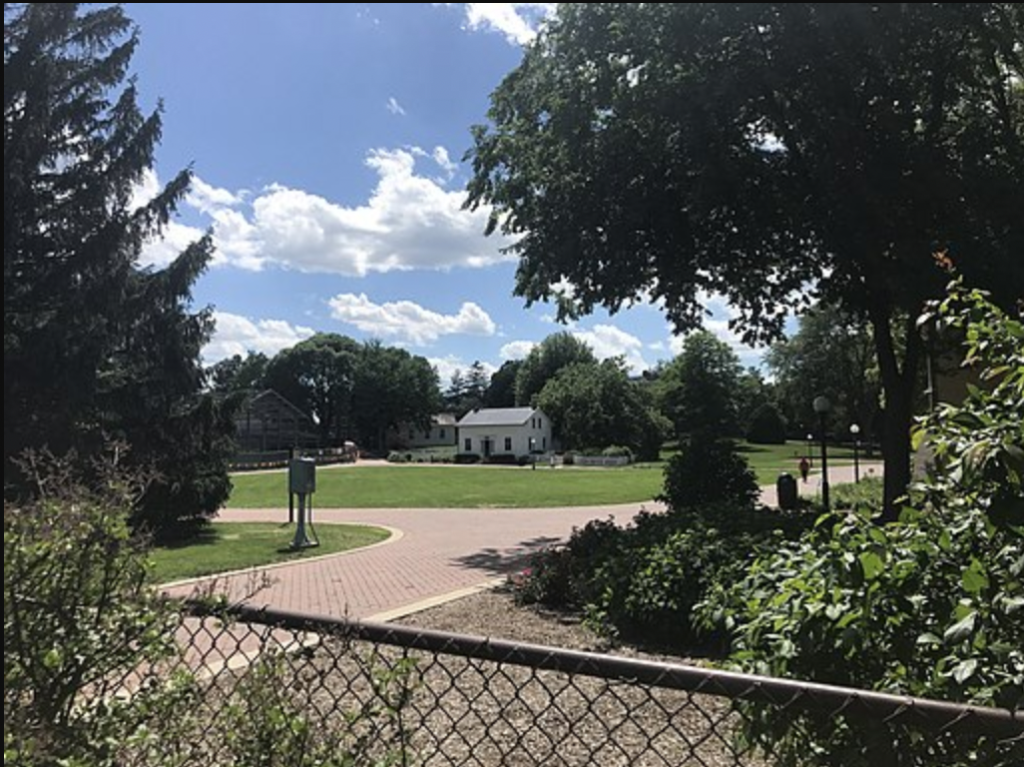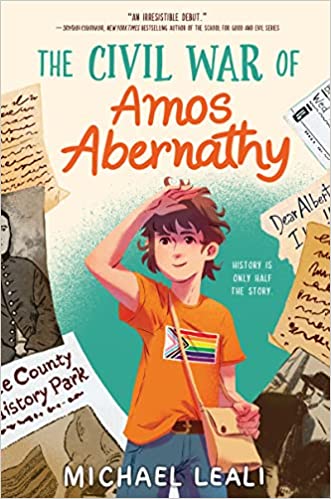craft post by Erin Nuttall
Parents. In children’s lit, the old saying applies, you can’t live with them, you can’t live without them. Parents are critical characters in children’s lives, but they can be tricky to write in a realistic way–often coming across as too perfect or too messed up or as the dreaded flat character, none of which are satisfying options. So, how can we write parents that are complex in their own right, but also–and this is essential–serve the story?
In Michael Leali’s Middle Grade debut, The Civil War of Amos Abernathy, the main character Amos is a middle school historical reenactor at the Living History Park where his single mom is the director. Amos’s story switches back and forth between the present, during the big finale of Civil War Remembrance Week, and the letters Amos writes to an historical trans man, Albert D.J. Cashier, in the months leading up to it. While the relationship between Amos and his mom is generally good, throughout the story it goes through rough patches that are entirely realistic and in keeping with both the story and both Amos’s and Mom’s development. Leali pulls off the parental balancing act with aplomb and creates a mom who tries, messes up, seeks forgiveness, and tries again. It is a master class in how to create a complex parental character.
Problems in Parent-land
In the present timeline, the reader learns that things are off between Amos and his mom.
The less I see of Mom before three o’clock, the better…. Her hand tentatively finds my shoulder, the way you might reach out to find a light switch in the dark. I don’t pull away, even though I want to… And then her hand is gone, and I don’t know how I feel. That’s the closest we’ve gotten to a hug, a shoulder squeeze, even a handshake in a while. Maybe I miss things being normal with Mom more than I realize. (pages 34-35)
Throughout the story we find out the causes of the rift between Amos and his mom. Leali clearly shows how Mom wants to support LGBTQ+ people and people of color at the Living History Park and how she also faces adult-world stumbling blocks to her beliefs and goals. When Amos came out to her, she hugged him and has supported him ever since. He has seen her beliefs in action and is confused by what he sees as her inaction. Amos wants her acceptance of him to apply to how she handles her job.
The first time Mom disappoints Amos is when his best friend Chloe applies to be a blacksmith apprentice, but the blacksmith doesn’t want to take Chloe on. He says it’s not because as a Black girl it wouldn’t be historically accurate for her to be an apprentice but that he doesn’t want the liability of Chloe getting hurt because he doesn’t believe that she’s up for the task. Mom says she’s unable to force him to take Chloe as an apprentice (165). Neither kid feels like this is a legitimate reason, especially once the blacksmith takes on a white boy as an apprentice, but Mom says there’s nothing she can do.
The next time Mom’s response lets the kids down is on one evening when Amos and Chloe are in the main gallery, and they look at a picture of a white soldier and an enslaved Black boy. Chloe explains the hidden racism of its caption: “Shiloh, Tennesee: Unidentified Illinois soldier from the Twenty-Seventh Infantry holding a Springfield rifle.” She explains to Amos, “The Black boy has been totally erased. That description ignores that he’s even in the picture, like he’s as important as the tent or the sky. Just a part of the background. The freaking rifle gets a mention, but not him” (182). When Amos tells her they should tell his mom, that she’d fix it and all the other racist captions, Chloe says she already did–nearly a year earlier. Even though Mom said she’d look into it, she still hasn’t updated the exhibits to include descriptions of the enslaved Black people in the photos.
Parental Growth Throughout
Leali doesn’t leave Mom’s redemption for the end of the story, but allows her to reevaluate, change, and grow throughout. Mom tells Amos and Chloe: “I’ve been thinking a lot about what you and Amos said last night and how I reacted hasn’t sat well with me. I hate that I told you that this [Chloe as the blacksmith’s apprentice] wasn’t a battle worth fighting” (198). She goes on to apologize and explain that she also came across an old email from Chloe regarding the plaques in the gallery and that she feels terrible for dropping the ball. That Chloe’s request was important and that she’ll fix things right away. Leali could have stopped there, but he has Mom dig deeper and do some self-examination.
But Mom went on. “Looking at how that happened, that revealed some ugly things in me I didn’t want to look at. When it comes to race, and hard as it is for me to believe as a woman, gender, I have been irresponsible. I’ve been telling myself we don’t have issues at the LHP. It’s uncomfortable for me to admit, but I’m starting to see just how much racism and sexism are embedded in how we operate. And now that I see it, I will not stand for [it]. If Chase can be Brad’s apprentice, so should you…. I’m learning a lot from you [Chloe] and Amos. I want to thank you both and apologize for not being there for you sooner. (199-200)
Even as a person who is trying to be inclusive and anti-racist, Mom is not perfect. But Leali has her see where she fell down, apologize, check the origin of the harm, fix the harm, and promise to do better. In doing so he creates a complex character who can also serve as an example to anyone who, like Mom, is trying and wants to do better.
But Mom still isn’t perfect, and her third strike happens when she doesn’t stand up to the Living History Park’s biggest donor when he pushes his daughter’s special exhibit proposal about historical shoes over Amos and Chloe’s exhibit proposal to showcase historical LGBTQ+ people.
Mom’s fingers were massaging the base of her neck. “He threatened to pull all of his funding from the Living History Park….” She couldn’t even look at me as she said it.
… “So the board is going to let [him] bully them because they’re afraid of losing a little money?”
“It’s not a little money, Amos. [They] fund a huge portion of the LHP. Without them, we’d have to shut down operations almost immediately. Never mind the fact that some board members truly think it’s the right thing to do….Of course I think it’s ridiculous, but we can’t lose the[ir] donation. We just… we don’t have the revenue to cover our costs. We’re talking about my job, Amos. Our livelihood. (167)

This situation is realistic: a well-researched historical presentation about marginalized people would be a fantastic special exhibit, but there are frequently financial and other survival-level difficulties that adults face in carrying out idealistic proposals even when they want to, even at the expense of loved ones and justice.
Because Amos and Chloe feel they can’t trust Mom to support them at the cost of LHP’s biggest donor, they team up with their friends and go around Mom and plan a surprise presentation, highlighting queer historical figures, for the biggest day–and biggest audience–of Civil War Remembrance Week. After the kids put on their presentation Amos experiences some of the real-world consequences that Mom has been facing when the biggest donor, Mr. Simmons, explodes at Mom, Amos, and Chloe. After his tirade Mom responds:
Her focus stays firmly on Mr. Simmons, but her hand rests on my shoulder. “This is not your park to run, Mr. Simmons. And my son isn’t spouting ‘liberal propaganda’–he shared well-researched, unadulterated truth. Had you read his proposal last fall you’d know that.”
I do a double take. Mom’s face is serious. And she’s defending me. To Mr. Simmons. (268)
This is where Mom really shines. She stands up for Amos and Chloe and inclusion, and she risks her job by doing so. Leali uses the mirroring of Mom’s hand on Amos’ shoulder in the scene from the beginning of the book when Amos is upset with Mom (34-35) and this scene where Mom publicly comes through for him to underline the similarities and differences of the situations. Leali gives Mom the opportunity to make up for past mistakes in a big way, to really let Amos know that she always has his back, even if it might take her some time to understand how best to do that.
Adult Growth Deepens Relationships
In The Civil War of Amos Abernathy, Leali empowers the children to act and the parent to reflect and change. He gives a road map for writers who want to expand their adult characters and thereby deepen the relationships between the adults and the children. Mom’s change not only tells us about her but helps us understand Amos and his growth and change.
Now it’s YOUR turn . . .
- How can your adult character fail?
- How can your adult character redeem themself?
- What situation can you put your characters in that the adults and the children want the same outcome but go about the solution in different, conflicting ways?
- How can they come together? One apologizes & changes? Both apologize & change?
- Consider how you can mirror scenes from early in your story and later in your story to highlight the change in characters and in the relationship between the adult and your main character.
Check out these other posts on Secondary Characters!
Erin Nuttall holds an MFA in Writing for Children and Young Adults from Vermont College of Fine Arts and is an active member of SCBWI and ALAN. She lives outside of Chicago with her family where she writes stories for middle grade and young adult readers that offer a humorous take on friendship, identity, feminism, and romance.



COMMENTs:
0